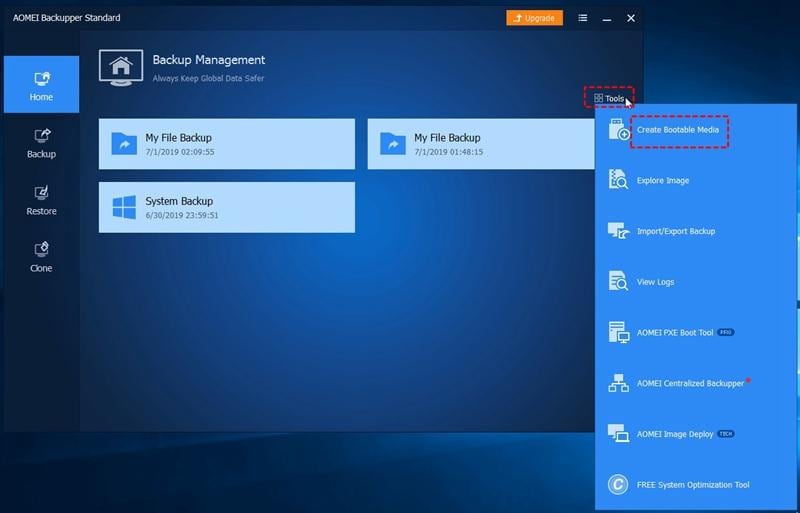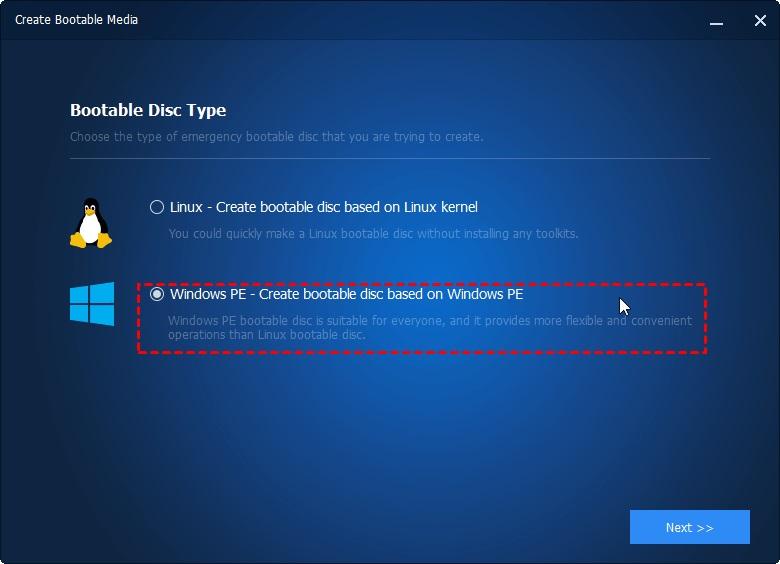Dec 12, 2025 • Filed to: Take Data Backup • Proven solutions
Booting from USB is one of the most common and effective methods of installing an operating system; however, it is determinant to remember that this process depends on the firmware configuration of your computer. In this post, we will explain why your computer won't boot from USB. Additionally, we will explain how you can solve it, and we will also show you an alternative to creating a bootable device with which you can access a light version of Windows. With that, you can make backups, repairs to your operating system, or even restore from an image.
Part 1: Fixed: Windows Won't Boot from USB Error
A computer is technically capable of booting from different types of devices, this includes USB devices. In the past, it used to be necessary to boot from floppy disks, CDs, or DVDs because they were the best option to install an operating system; also, they used to be the external storage methods with the highest storage capacity. However, this stopped being the case some ago years. Currently, operating systems are installed through pre-configured software to create a bootable USB; nevertheless, these bootable devices can fail due to the chaotic environment from which they must work, that is, the firmware.
In some cases, updating the firmware of your computer could solve "Windows won't boot from USB" problem permanently; nonetheless, there are many factors that you must take into account before opting for this alternative.
Computer firmware tends to vary depending on the model and manufacturer of the motherboard. Besides, the firmware on a motherboard does not update automatically, creating even more variations that can interfere with the compatibility of the hardware and its configurations.
Updating the firmware of a computer is not difficult, but it is not something you should take lightly either. It would be enough to make a mistake during the firmware update process, and the computer will suffer irreversible damage. For this reason, it is advisable to contact the manufacturer's technical service for assistance during this process and, if possible, avoid it.
Later we will talk about some methods that can help you correct PC not bootable from USB problem without updating the firmware of your computer.
Part 2: What Causes PC Won't Boot from USB?
Several possible causes can generate your Windows won't boot from USB; below I will list some of them.
Outdated Firmware: Remember that your computer's operating system and firmware perform similar functions but at different times. When you start your computer, the firmware is the software in charge of managing your computer's hardware. If this software is out of date, it may be unable to detect some devices.
Physically damaged USB ports: If the port you are connecting the USB device to has physical damage or dirt residue, this can hinder connectivity; if this is the case, try plugging the device into another port.
USB is not bootable: Remember that you can boot from a USB. The USB has to have a specific configuration. The files must have been previously configured to run in a firmware environment; therefore, copying and pasting a file will not be enough to be able to run it from the boot.
Wrong boot configuration: The firmware of any computer uses a boot hierarchy scheme. In this way, it first checks if there is an operating system installed to boot from it and, if not, it advances to the next position in the hierarchy scheme. Commonly, the second place belongs to an external storage medium such as CDs / DVDs, Floppy disks, or USBs. For everything to work correctly, you must assign the highest position in the hierarchy to the USB devices.
Part 3: How to Fix Windows Won't Boot from USB Error?
As we mentioned earlier, some methods allow you to solve pc won't boot from usb problem without the need to update your computer's firmware version. Next, I will show you the two main methods.
Method 1. Solve Windows Won't Boot from USB by Creating Portable Windows to USB
There are lighter versions of Windows designed as tools to fix configuration errors in systems. These operating systems have the same diagnostic and troubleshooting tools but would not be comfortable or efficient for everyday use. You can download and create your bootable USB with Windows PE (Windows Preinstallation Environment), although, to make this process easier, I recommend using AOMEI Backupper. This software is to perform any backup task ready and safely, but it also has a tool that allows you to create bootable devices with Windows PE ready and safely.
This software was designed to perform any backup process easily and safely, but it also has a tool that allows you to create bootable devices with Windows PE.
You can download this software through its official website. Below I will show you how to use it.
Step 1: Open the bootable media creation tool

When you have installed the software, go to the Tools section in the left panel of the window and select the option Create a Bootable Media.
Step 2: Choose an operating system

In this window, you can choose an operating system. Choose Windows PE and then click on Next.
Step 3: Choose the firmware compatibility mode

In this window, you must choose the type of compatibility that corresponds to the firmware of your computer. To select the correct option, you can consult the user manual of your computer or motherboard.
Step 4: Choose your USB device
Now you must select the USB Boot Device option, and then you must click the on Next button. (If your computer is unable to recognize the device you can add the necessary drivers by clicking the +Add drivers option; in this way, they will be loaded into RAM during the boot process).
Step 5: Wait for the process to finish
Wait for the process to finish and click on Finish. When finished, boot from the USB, and if you wish, you can use this portable version of Windows to use AOMEI Backupper to mount a system image and install Windows 10 correctly.
Method 2. Manually Fix Windows Won't Boot from USB Error
AOMEI Backupper is the best tool to fix PC won't boot from USB issue, but if you want to fix it manually, you can follow the steps below to identify the problem and solve it.
1. Check if the USB drive is bootable: Earlier, we explained why a bootable USB is different from a conventional USB. If you are not sure if your USB is bootable or not, you can try connecting it to another computer and trying to boot from it. If this computer can recognize the contents of the device as a bootable medium, then it means that the USB is bootable; otherwise, you will need to reconfigure the device to make it a bootable device.
2. Make sure your computer support booting from USB: There are some isolated cases where a computer does not support booting from USB, and this can be due to two reasons. The first is that your computer is old, and its firmware does not support to boot from USB devices, and the second is that your computer's firmware is out of date and is unable to control the USB ports during startup. If this is the case, I strongly recommend that you contact a professional who can update your computer's firmware. I do not recommend that you perform this procedure on your own due to the high level of risk involved in this process.
3. Set Computer/PC to boot Windows from USB: As simple as it may sound, a computer's firmware is not as sophisticated as an operating system and needs specific instructions, even when it comes to booting. To configure your computer to boot from a USB drive, you must access the firmware configuration menu (BIOS / UEFI) and then you must go to the Boot section. Once there, select the USB ports as the main boot method.
Conclusion
Booting a computer does not depend on the operating system but depends on the firmware installed. Firmware (BIOS / UEFI) is a software that manages your computer's hardware and operates at the most basic level possible. For this reason, if you want to boot from a USB device you must have properly configured the device and firmware before you can use it. However, there are tools like AOMEI Backupper that allow you to create bootable devices with a lighter version of Windows (WindowsPE), with which you can install Windows 10 or even restore from a backup image much more easily.
Data Backup Services
- Computer Backup
- Windows 10 Backup
- Windows 8 Backup
- Best File Sync Software
- Driver Backup
- SD Card Backup
- Best Incremental Backup
- Onedrive Automatic Backup
- Hard Drive Backup
- Mac Backup
- Cloud Backup

 ChatGPT
ChatGPT
 Perplexity
Perplexity
 Google AI Mode
Google AI Mode
 Grok
Grok
























Amy Dennis
staff Editor